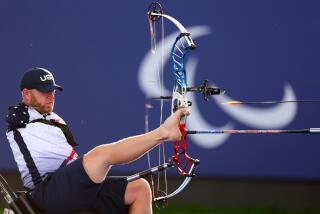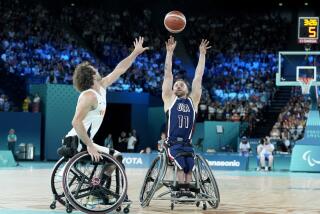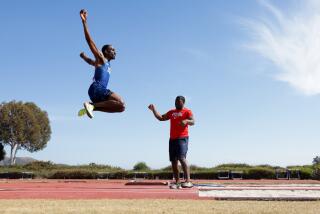The Will to Walk : Medicine: At a Southland clinic, a paraplegic Israeli veteran strives toward mobility, using an unorthodox contraption and a heavy dose of determination.
While Edan Kleiman was recovering in a Tel Aviv hospital from a bullet that sliced his spine and left him a paraplegic, he saw another wheelchair patient, his legs stiffly held straight out. Kleiman asked him what had happened. “He said, ‘I was told if I put boiling oil on my legs, I could walk again.’ ”
Kleiman recounts this bit of lunacy without smile or smirk, his face unreadable--a trait he likes to cultivate. (“I have this poker face,” he says.) All that shows is a hint of the determination of a 22-year-old Israeli war veteran made wiser and older by the violence of war.
“I said, ‘That won’t happen to me,’ ” Kleiman says evenly. “I don’t like illusions.”
And yet here he is at an unorthodox rehabilitation program in Beverly Hills run by a man who promises his patients what would seem to be the ultimate illusion: a chance at walking.
Not completely on his own. But with the help of an eight-pound contraption of leg braces and a waist-encircling pelvic girdle that has a cable mechanism in the back. This allows the wearer to use his upper body to move his legs. It’s like being your own marionette. A conventional walker or crutches allow for balance.
*
Kleiman and his Beverly Hills doctor, Paul Berns, a passionate supporter of Israel, are bound together by their determination to make Kleiman walk. They carry out their alliance in Berns’ small clinic.
To the uninitiated, who take walking blissfully for granted, and to some orthopedic surgeons, the device that Berns bestows with religious fervor upon his patients looks like a clumsy waste of energy. In fact, Kleiman’s first efforts to negotiate the braces were as difficult and discouraging as surfing--a comparison Kleiman’s apartment roommate, Yair Tsur, made for him.
“Yair saw me trying to walk. I said, ‘Look, we came here for nothing. My legs aren’t moving,’ ” Kleiman said. “He said, ‘Look, I tried surfing. For one week, I couldn’t do it.’ Then he said, ‘The mind tells the body what to do.’ ”
So Kleiman, shot by a sniper on the Gaza Strip in 1992, wrestles with his mind and his body and his braces to forge the exquisite synthesis that is walking. “Don’t forget, the last time I was walking was two years ago,” he says. “I don’t even dream myself walking.”
Yet he yearns to change the reality that he cannot walk. “You don’t accept it. You learn to live with it. You always want to walk.”
*
In Berns’ clinic, Kleiman undergoes several hours of therapy a day, along with other patients, including gang members felled in the street wars of Los Angeles.
“It’s more dangerous than my army,” Kleiman says one day at the clinic as he eyes a onetime gang warrior injured in a shooting. “ We have medics.”
Kleiman, whose care and living expenses are paid for by the Israeli defense ministry, is comfortable at the clinic after five months here. He chats curiously with gang members, baffled by the violence they have embraced. He spars verbally and playfully with Roy Douglas, the creator of his walking apparatus, known as the Douglas Reciprocating Gait Orthosis, teasing Douglas about his British accent. Douglas is the person who fits every patient with the orthosis and helps train each one to use it.
Berns and Douglas say that not all people in wheelchairs can master the device. Even when they do, none is expected to use it more than an hour or two a day.
“It’s a way to get out now and then,” says Berns, an internist who is accustomed to a skeptical response from orthopedic surgeons. “Some people use it around the house. . . . Some people like to use it in social situations. But we never say the brace is going to take the place of the wheelchair.”
Kleiman flashes passion and anger at the notion that the device is either too much trouble (“I can put on the RGO system and stand up faster than you can put on makeup”) or too awkward a substitute for walking.
“What you’re talking about is looking funny,” Kleiman says. “So people think I look funny.”
Even if he never takes a step in the device, it offers the six-foot former soldier a chance to stand up.
“I would rather look people in the eye than look up at people,” he says.
Douglas listens to Kleiman and adds, “In life, you see people walking--some glide, some struggle. You see the same thing in people with RGOs--some glide, some struggle.”
Berns and Douglas are not the only doctors and orthotists working with brace systems that bring paraplegics upright and allow some of them to walk. Berns says the system he uses is more lightweight and geared to inducing a more natural gait than other braces. But some doctors are less than excited about it.
“Most people end up being more energy-efficient in a [wheelchair],” said one orthopedic surgeon who has seen patients in a variety of brace-like devices and spoke on the condition he not be identified. “But I think mentally it’s exciting for these patients. They have a goal to work on.”
Dr. Bob Waters, an orthopedic surgeon and medical director of the highly respected Rancho Los Amigos Medical Center in Downey, says it is difficult to predict the best candidates for the program.
“You could say: ‘It’s just a brace, if it doesn’t work, throw it away,’ ” Waters said. But, he adds, there is still a risk: “It takes people’s time, it builds up their expectations, they may have to borrow money.”
*
It’s not cheap. The device costs $12,000. Physical therapy can run an additional $250 to $500 a day. Berns estimates Kleiman’s six months of treatment and braces will total about $30,000.
Getting the braces is not like buying a car and driving off. “You need at least four months of rehabilitation therapy to make the walking safe and functional,” says Berns, who acts as therapist. “It is not good to be able just to stand up and fall over.”
Berns, 59, was practicing internal medicine with half of his practice devoted to sports medicine before he took time to help rehabilitate a close friend with a spinal cord injury in 1980. That led him to involvement with spinal cord rehabilitation and eventually a business relationship with Douglas. Now, this is his main work.
“We treat our patients here as athletes,” he says. “Their sport is walking.”
One of Berns’ frequent visits to Israel--where he has long been involved in working with Israeli athletes--led to a meeting with Kleiman, who had just begun his recuperation after being wounded while his unit was on patrol in November, 1992, during the Palestinian uprising.
Kleiman was not ready to talk to anyone about programs then. It wouldn’t be until July, 1993, when Kleiman again met Berns that he began to seriously consider the doctor’s treatment.
The Israeli government pays for all of Kleiman’s care and living expenses. “We are really very proud of this,” says Yoram Ben Ze’ev, the Israeli consul general in Los Angeles. “When our youngsters unfortunately become disabled, we take care of them for the rest of their lives.”
Ben Ze’ev has visited Berns’ clinic and seen Kleiman in the midst of his therapy.
“I was there the first time he stood on his own,” says Ben Ze’ev. “It was very heartbreaking to see a guy like Edan need all these accessories to move his legs. But I know he’s made of steel.”
Kleiman greets you in a wheelchair at the door to his Westwood apartment--which he shares with Tsur, his friend from Israel--wearing overalls, his blond hair pulled back in a ponytail. If not made of steel, he is a brawny man, ferociously independent. He lived on his own in Israel after leaving the rehabilitation hospital rather than move back into his parents’ home, and dared to tour the rugged terrain of Thailand. In Israel he drove a car with hand controls; here he drives a similarly equipped black Chrysler LeBaron convertible.
He found his $1,700-a-month, two-bedroom apartment with the help of his roommate. Together they go to coffeehouses, a few movies, even Venice Beach.
Tsur taught himself to skate on the boardwalk by clutching the handles of Kleiman’s wheelchair as Kleiman pushed the wheels himself. If any young woman cast too admiring a glance in Tsur’s direction, laboring under the mistaken impression that Tsur was skating and pushing his friend, Kleiman gave his chair wheels a fast roll that sent Tsur tumbling.
*
Kleiman disdains being called a hero. He was stepping into a military vehicle when he was shot--unlike his father, who, according to Kleiman, was wounded in the 1973 Yom Kippur War as comrades around him fell. “After he got shot, he took his Uzi and kept shooting with one hand until he fainted,” according to the son. He lost his maternal grandfather in Israel’s War for Independence in 1948.
“It really bothered me that I didn’t get a chance to prove myself in war,” says Kleiman, who notes that in Israel it is considered an honorable duty to serve in the military.
These days he is more focused on mastering his braces. At the moment, he uses them only for brief periods outside of his therapy. He used them one weekend for a simple errand: “It was very hard to go from here to the lobby to pick up the mail.”
But that is his life, learning how to pick up the mail, learning how to live as normally as possible. Every now and then his friends slip--and ask him to play soccer.
“People forget,” he says. “And I’m glad.”
More to Read
Sign up for Essential California
The most important California stories and recommendations in your inbox every morning.
You may occasionally receive promotional content from the Los Angeles Times.











